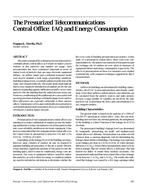Description
This study evaluated the continuous pressurization of telecommunications central offices as it relates to indoor concentrations of fine particles and outdoor air usage. Such pressurization has been considered important in terms of indoor levels of particles that can cause electronic equipment failures. An airflow model and a pollutant transport model were used to simulate a wide range of operating conditions. Building leakage levels, essentially unknown at the time of the study, were measured directly. The results of this study indicate that in most situations introduction of outdoor air for the sole purpose of guarding against infiltration actually carries more particles into the building than the added pressure keeps out. Moreover, conditioning of this additional air is associated with an energy premium. Buildings with high leakage levels and low filter efficiencies are especially vulnerable to these adverse effects. Maintenance of low and controllable pressurization to avoid unintentional depressurization, however, is preferable to striving for a neutral indoor pressure.
Paper from IAQ 1997 — Design, Construction, and Operation of Healthy Buildings: Solutions to Global and Regional Concerns
Citation: IAQ Conference: IAQ 97
Product Details
- Published:
- 1997
- Number of Pages:
- 4
- File Size:
- 1 file , 45 KB
- Product Code(s):
- D-25159




